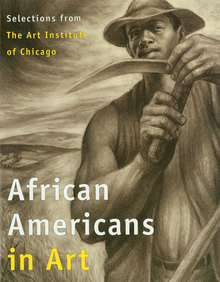Horace Pippin, American Modern
WARNING
You are viewing an older version of the Yalebooks website. Please visit out new website with more updated information and a better user experience: https://www.yalebooks.com

Read this book online via the A&AePortal, our art and architectural history eBook platform. To learn more about how to access this book, please contact us.
A nuanced reassessment that transforms our understanding of this self-taught artist
Arguably the most successful African American artist of his day, Horace Pippin (1888–1946) taught himself to paint in the 1930s and quickly earned international renown for depictions of World War I, black families, and American heroes Abraham Lincoln, abolitionist John Brown, and singer Marian Anderson, among other subjects. This volume sheds new light on how the disabled combat veteran claimed his place in the contemporary art world. Organized around topics of autobiography, black labor, artistic process, and gift exchange, it reveals the range of references and critiques encoded in his work and the racial, class, and cultural dynamics that informed his meteoric career. Horace Pippin, American Modern offers a fresh perspective on the artist and his moment that contributes to a more expansive history of art in the 20th century. Featuring over 60 of Pippin’s paintings, this volume also includes two previously unknown artist’s statements—“The Story of Horace Pippin as told by Himself” and “How I Paint”—and an exhibition history and list of artworks drawn from new research.
Arguably the most successful African American artist of his day, Horace Pippin (1888–1946) taught himself to paint in the 1930s and quickly earned international renown for depictions of World War I, black families, and American heroes Abraham Lincoln, abolitionist John Brown, and singer Marian Anderson, among other subjects. This volume sheds new light on how the disabled combat veteran claimed his place in the contemporary art world. Organized around topics of autobiography, black labor, artistic process, and gift exchange, it reveals the range of references and critiques encoded in his work and the racial, class, and cultural dynamics that informed his meteoric career. Horace Pippin, American Modern offers a fresh perspective on the artist and his moment that contributes to a more expansive history of art in the 20th century. Featuring over 60 of Pippin’s paintings, this volume also includes two previously unknown artist’s statements—“The Story of Horace Pippin as told by Himself” and “How I Paint”—and an exhibition history and list of artworks drawn from new research.
Anne Monahan is an art historian based in New York.
“Not only does Anne Monahan offer insights into the mind and methods of Horace Pippin, but she also gives us a rarely explored, comprehensive view into the inner workings of a burgeoning American art scene, an enterprise which relied upon this self-taught luminary for its own identity and advancement.”—Richard J. Powell, Duke University
“Monahan has achieved such an impressive sense of Pippin's internal developments and career-long motifs that she can adeptly shuttle between works, genres, and themes to build complex arguments about the artist’s cumulative impact.”—Jennifer Jane Marshall, University of Minnesota
“Monahan challenges the predominant narrative of Pippin’s life and work, convincingly demonstrating the problems of previous scholarship and providing sound evidence for her own.”—John P. Bowles, University of North Carolina at Chapel Hill
“This comprehensive study of Pippin absorbs previous scholarship but is perhaps the most thorough and inclusive analysis of a luminary and true original, briefly at center stage.”—Douglas F. Smith, Library Journal
“In Horace Pippin, American Modern, Monahan takes up the very issue of how we are to think about the artist now. . . . Focusing rather on certain aspects of Pippin’s work—on how he derived some of his images, on the meanings of his handful of pictures showing cotton fields, and on the way he often made gifts of his artworks to well-connected patrons—she attempts to remove what she calls the ‘homespun’ from our sense of the artist. . . . Monahan’s study is of a piece with a number of recent and forthcoming books that aim to show self-taught (or outsider) artists as more in control of their endeavors than previously thought.”—Sanford Schwartz, New York Review of Books
“An exceptionally rich and compelling reading of the artist’s life and work. . . . This is important work and Monahan does it well, challenging the hidden baggage of art historical discourse. Thoroughly grounded in original research and the close reading of the artist’s oeuvre, Horace Pippin is required reading for grasping the complex and complicated social practice of the history of art.”—Choice
“Horace Pippin, American Modern offers a fresh perspective on the artist and his moment that contributes to a more expansive history of art in the twentieth century.”—Antiques and the Arts Weekly
“Horace Pippin shines in the midst of an overdue racial reckoning in the United States, to which it makes a substantial scholarly contribution.”—Clara Barnhart, caa.reviews
“[T]his well-researched study challenges the continued classification of Pippin as a naïve outsider artist [and] expands our understanding of modern art in the United States.”—Rebecca VanDiver, Panorama: Journal of Historians of American Art
“To resist a purely biographical reading, Monahan's book replaces historical teleology with a thematic structure arranged in chapters...Nothing is taken for granted, and Pippin cyclically emerges and re-emerges out of a narrative driven by forensic readings of specific works, both iconographically and as visual reference to contemporary lived experience.”—Colin Rhodes, The Burlington Magazine
Winner of a grant from the Wyeth Foundation for American Art Publication Fund of CAA
ISBN: 9780300257533
Publication Date: February 25, 2020
Publication Date: February 25, 2020
264 pages, 0 x 0





